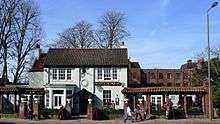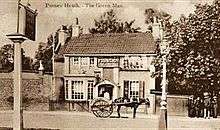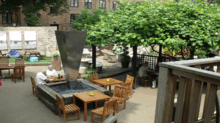Green Man, Putney
The Green Man is a public house in Wildcroft Road, Putney, London, on the edge of Putney Common, parts of which date back to around 1700. The pub was once frequented by highwaymen and was a popular place for participants to fortify themselves before or after a duel on nearby Putney Heath.




History
A pub has stood on the spot since around 1700.[1] It is located opposite the grade II listed village pound.[2]
Notable regulars have included the poet, playwright, novelist, and critic Algernon Charles Swinburne, who lived at The Pines, Putney, and is said to have always stopped in for a drink en route to the Rose and Crown in Wimbledon.[3]
Duels
The pub is close to what was a location for duels, and according to legend, participants would visit the pub before or afterwards[1] giving rise to the local saying "pistols for two and breakfast for one".[2]
In 1667, the Earl of Shrewsbury was killed by the Duke of Buckingham with a single blow from his sword, leaving him free to pursue Lady Shrewsbury.[4]
In May 1798, the then Prime Minister, William Pitt fought a duel with George Tierney, the MP for Southwark, on Putney Heath. Each fired twice and all the shots missed but the event was the talk of the pub.[3][5]
In 1809, future Prime Minister, George Canning fought a duel with fellow Cabinet member Lord Castlereagh, and was shot in the thigh, and Castlereagh helped him limp from the scene.[5]
Highwaymen
Putney Heath was also known for the activity of highwaymen. Joseph Witlock and William Brown preyed on the intoxicated as they went home from the Green Man. Both were hanged at Tyburn in 1773.[2] Dick Turpin is said to have hidden his guns in a room upstairs, but this may only be a legend.[4]
Fellow highwayman Jerry Abershawe was based there,[6] and after he was hanged on 3 August 1795 on Kennington Common, his corpse was gibbeted (displayed on a gallows) outside the pub, the last hanged highwayman's body to be so exhibited.[3] Nearby Tibbet's Corner is thought to be a corruption of the word gibbet.[2]
Present day
The once common pub game, ringing the bull, was still played at the pub in 1998.[3] The pub is now inside the Putney Heath Conservation Area.[2]
"Putney Heath / Green Man" is used as the name of the final destination (terminus) for several London bus routes: 14, 37, 85, 170, 424, 493, 639 and 670, and there is a mini-bus station nearby.[7]
References
- "Green Man". Young's. Retrieved 20 February 2016.
- Putney Heath Conservation Area Appraisal and Management Strategy. London Borough of Wandsworth, London, 2010.
- Sullivan, Edward (1998). The London pub & bar guide 1999. London: Simon and Schuster. pp. 95–96. ISBN 978-0-684-86840-0. Retrieved 19 February 2016.
- "Putney Heath". Manor Fields. Archived from the original on 4 March 2016. Retrieved 25 February 2016.
- McNeill-Ritchie, Simon; Ron Elam (2015). Putney & Roehampton through time. Stroud: Amberley Publishing Limited. p. 169. ISBN 978-1-4456-4739-5.
- Harper, Charles G. (1906) The old inns of old England: A picturesque account of the ancient and storied hostelries of our own country. Vol. I. London: Chapman & Hall. p. 319.
- Putney Heath / Green Man. Transport for London. Retrieved 27 February 2016.